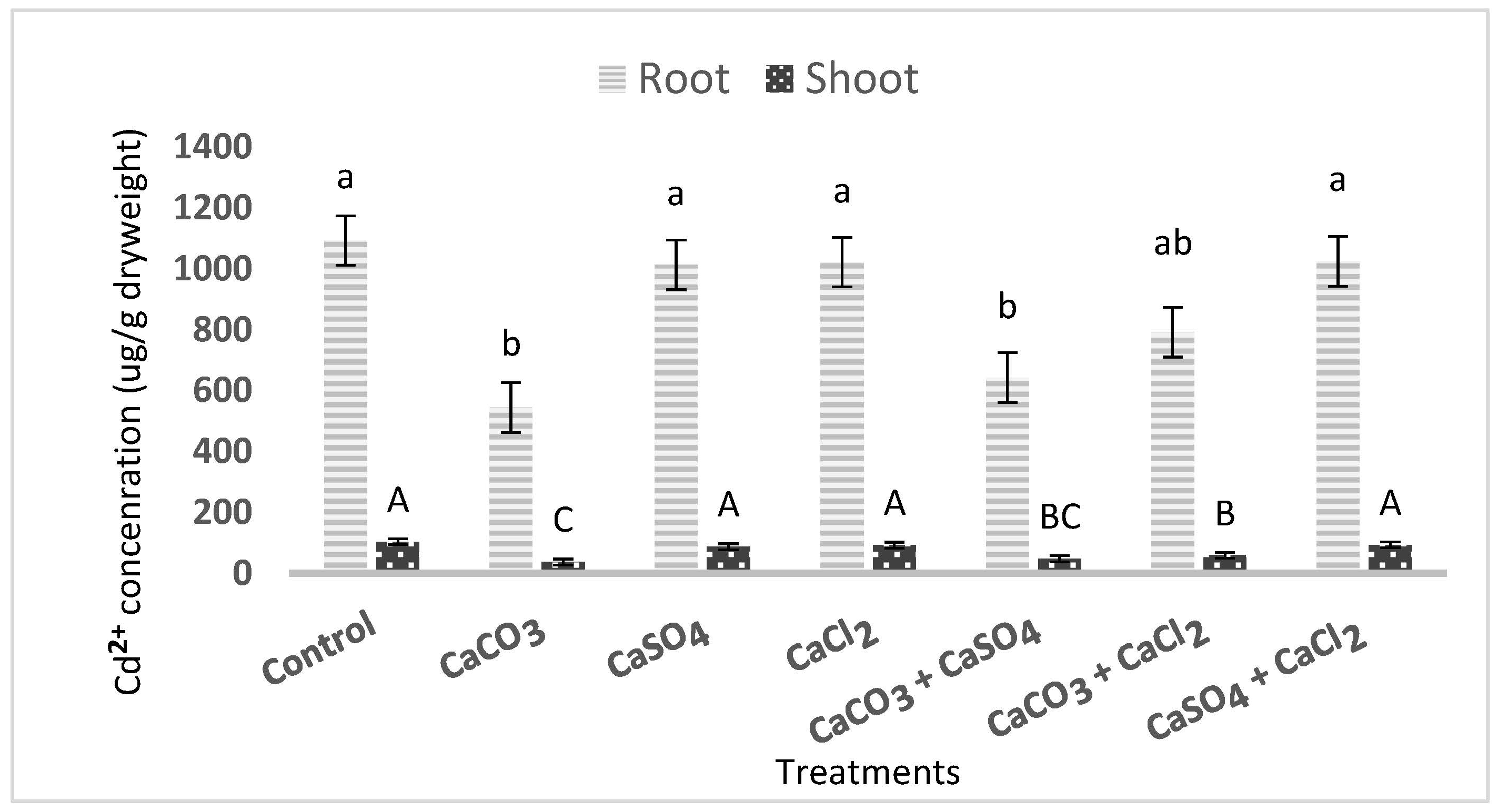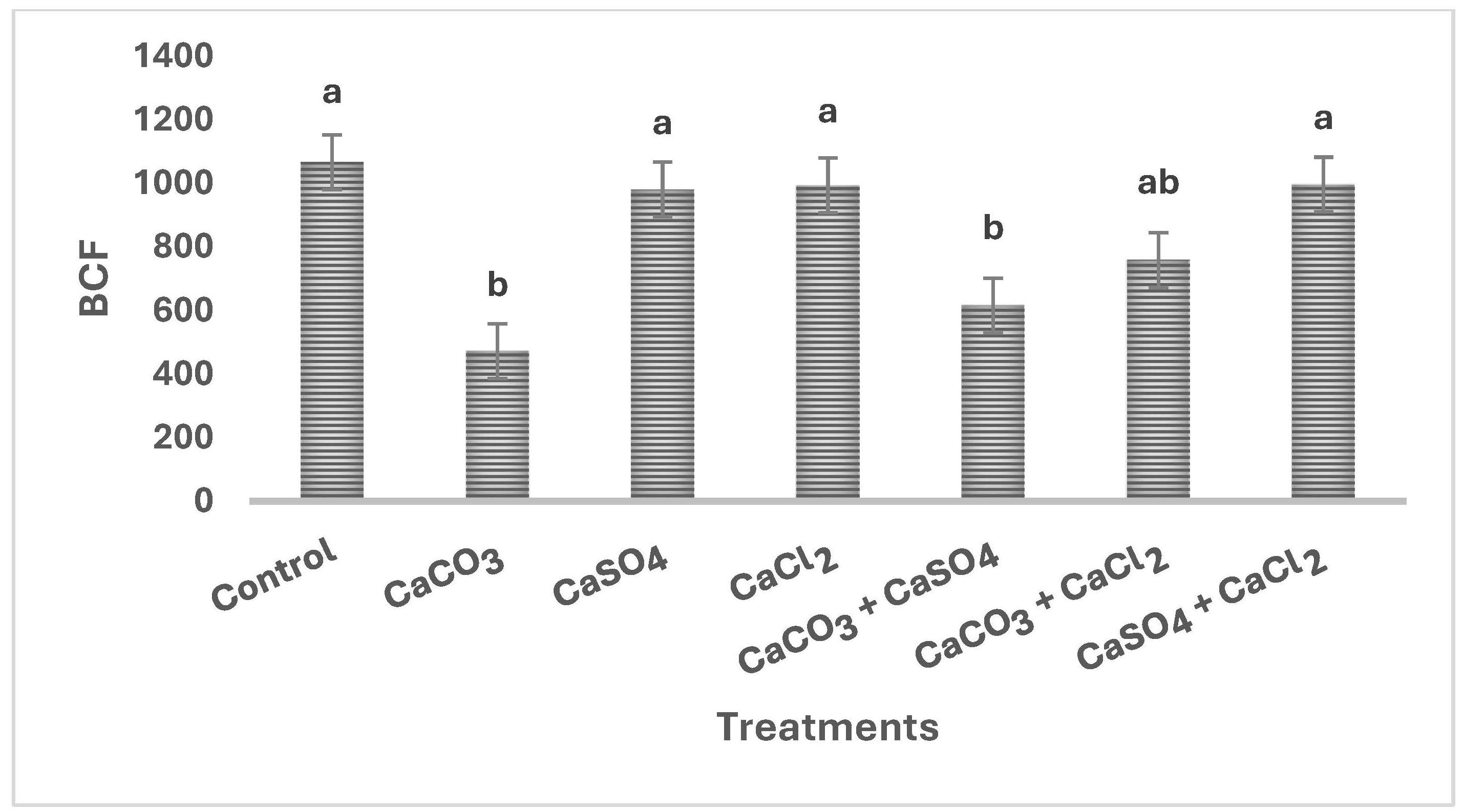Calcium-Associated Anions Play a Dual Role in Modulating Cadmium Uptake and Translocation in Wheat
Abstract
:1. Introduction
2. Materials and Methods
2.1. Plant Growing Conditions
2.2. Elemental Analyses
2.3. Statistical Analysis
3. Results
3.1. Effect of Ca2+ Treatments on Cd2+ Uptake and Translocation in Wheat
3.1.1. Effect of Ca2+ Treatments on pH of Nutrition Solution
3.1.2. Effect of Calcium Treatments on Root and Shoot Fresh Biomass
3.1.3. Effect of Ca2+ Treatments on Cd2+ Concentration in Wheat and Bioconcentration Factor
3.2. Effect of Ca2+ Treatments on Nutrient Uptake
4. Discussion
4.1. Effect of Ca2+ Treatments on Cd2+ Uptake and Translocation in Wheat
4.2. Effect of Ca2+ Treatments on Nutrient Uptake
5. Conclusions
Author Contributions
Funding
Data Availability Statement
Acknowledgments
Conflicts of Interest
References
- Huang, J.; Wang, C.; Qi, L. Phosphorus is more effective than nitrogen in restoring plant communities of heavy metals polluted soils. Environ. Pollut. 2020, 266, 115259. [Google Scholar] [CrossRef] [PubMed]
- Fatima, G.; Raza, A.; Hadi, R.; Hadi, N.; Mahdi, A.A. Cadmium in human diseases: It’s more than just a mere metal. Indian J. Clin. Biochem. 2019, 34, 371–378. [Google Scholar] [CrossRef] [PubMed]
- Järup, L.; Akesson, A. Current status of cadmium as an environmental health problem. Toxicol. Appl. Pharmacol. 2009, 238, 201–208. [Google Scholar] [CrossRef] [PubMed]
- Clemens, S.; Aarts, M.; Thomine, S.; Verbruggen, N. Plant science: The key to preventing slow cadmium poisoning. Trends Plant Sci. 2013, 18, 92–99. [Google Scholar] [CrossRef] [PubMed]
- Rahim, H.U.; Akbar, W.A.; Alatalo, J.M. A Comprehensive Literature Review on Cadmium (Cd) Status in the Soil Environment and Its Immobilization by Biochar-Based Materials. Agronomy 2022, 12, 877. [Google Scholar] [CrossRef]
- Bolan, N.S.; Adriano, D.C.; Mani, P.A.; Duraisamy, A. Immobilization and phyto availability of cadmium in variable charge soils. II. Effect of lime addition. Plant Soil 2003, 251, 187–198. [Google Scholar] [CrossRef]
- Rehman, M.Z.; Rizwan, M.; Ghafoor, A.; Naeem, A.; Ali, S.; Sbir, M.; Qayyum, M.F. Effect of inorganic amendments for in situ stabilization of cadmium in contaminated soils and its phyto-availability to wheat and rice under rotation. Environ. Sci. Pollut. Res. 2015, 22, 16897–16906. [Google Scholar] [CrossRef] [PubMed]
- Hailu, B.; Estifanos, S. Investigating the effect of gypsum powder on chemical constituents of soil and selected crops, Adigudem, Tigray, Ethiopia. Momona Ethiop. J. Sci. 2021, 13, 164–176. [Google Scholar] [CrossRef]
- Wu, J.; Sagervanshi, A.; Mühling, K.H. Sulfate facilitates cadmium accumulation in leaves of Vicia faba L. at flowering stage. Ecotoxicol. Environ. Saf. 2018, 156, 375–382. [Google Scholar] [CrossRef] [PubMed]
- Argüello, D.; Dekeyrel, J.; Chavez, E.; Smolders, E. Gypsum application lowers cadmium uptake in cacao in soils with high cation exchange capacity only: A soil chemical analysis. Soil Sci. 2022, 73, e13230. [Google Scholar] [CrossRef]
- He, Z.Z.; Chai, M.; Wei, Y. Effects of CaCl2 on the Cd accumulation and stress of Spartina alterniflora. Chin. J. Ecol. 2013, 32, 1571–1577. [Google Scholar]
- Mei, X.; Li, S.; Li, Q.; Yang, Y.; Luo, X.; He, B.; Li, H.; Xu, Z. Sodium chloride salinity reduces Cd uptake by edible amaranth (Amaranthus mangostanus L.) via competition for ca channels. Ecotoxicol. Environ. Saf. 2014, 105, 59–64. [Google Scholar] [CrossRef] [PubMed]
- Hayakawa, N.; Tomioka, R.; Takenaka, C. Effects of calcium on cadmium uptake and transport in the tree species Gamblea innovans. Soil Sci. Plant Nutr. 2011, 57, 691–695. [Google Scholar] [CrossRef]
- Nazar, R.; Iqbal, N.; Masood, A.; Khan, M.I.R.; Syeed, S.; Khan, N.A. Cadmium toxicity in plants and role of mineral nutrients in its alleviation. Am. J. Plant Sci. 2012, 3, 1476–1489. [Google Scholar] [CrossRef]
- Roth, U.; Roepenack-Lahaye, E.V.; Clemens, S. Proteome changes in arabidopsis thaliana roots upon exposure to Cd2+. J. Exp. Bot. 2006, 57, 4003–4013. [Google Scholar] [CrossRef] [PubMed]
- Papoyan, A.; Kochian, L.V. Identification of Thlaspicaerulescens Genes That May Be Involved in heavy metal hyperaccumulation and tolerance. Characterization of a novel heavy metal transporting ATPase. Plant Physiol. 2004, 136, 3814–3823. [Google Scholar] [CrossRef] [PubMed]
- Ali, U.; Zhong, M.; Shar, T.; Fiaz, S.; Xie, L.; Jiao, G.; Ahmad, S.; Sheng, Z.; Tang, S.; Wei, X.; et al. The influence of pH on cadmium accumulation in seedlings of rice (Oryza sativa L.). J. Plant Growth Regul. 2020, 39, 930–940. [Google Scholar] [CrossRef]
- Liu, J.; Feng, X.; Qiu, G.; Li, H.; Wang, Y.; Chen, X.; Fu, Q.; Guo, B. Inhibition roles of calcium in cadmium uptake and translocation in rice: A Review. Int. J. Mol. Sci. 2023, 24, 11587. [Google Scholar] [CrossRef] [PubMed]
- Qin, S.; Liu, H.; Nie, Z.; Rengel, Z.; Gao, W.; Li, C.; Zhao, P. Toxicity of cadmium and its competition with mineral nutrients for uptake by plants: A review Shiyu. Pedosphere 2020, 30, 168–180. [Google Scholar] [CrossRef]
- Manzoor, M.; Abdalla, M.A.; Hussain, M.A.; Mühling, K.H. Silicon-Selenium interplay imparts cadmium resistance in wheat through an up-regulating antioxidant system. Int. J. Mol. Sci. 2024, 25, 387. [Google Scholar] [CrossRef] [PubMed]
- Mourato, M.; Pinto, F.; Moreira, I.; Sales, J.; Leitão, I. The Effect of Cd stress in mineral nutrient uptake in plants. In Cadmium Toxicity and Tolerance in Plants; Elsevier: Amsterdam, The Netherlands, 2019; pp. 327–348. [Google Scholar] [CrossRef]



| Treatment | pH |
|---|---|
| Control | 6.62 ± 0.02 c |
| CaCO3 | 7.82 ± 0.03 a |
| CaSO4 | 6.44 ± 0.02 d |
| CaCl2 | 5.78 ± 0.04 f |
| CaCO3 + CaSO4 | 6.72 ± 0.02 b |
| CaCO3 + CaCl2 | 6.79 ± 0.02 b |
| CaSO4 + CaCl2 | 6.30 ± 0.04 d |
| Cd2+ Concentration | BCF | TF | ||
|---|---|---|---|---|
| Root | Shoot | |||
| pH | −0.57 ** | −0.65 ** | −0.59 ** | −0.25 ns |
| Ca2+ | −0.26 ns | −0.40 * | −0.28 ns | −0.41 * |
| CO32+ | −0.69 ** | −0.87 ** | −0.71 ** | −0.47 * |
| SO42+ | 0.07 ns | 0.05 ns | 0.07 ns | −0.08 ns |
| Cl− | 0.23 ns | 0.24 ns | 0.24 ns | −0.004 ns |
| Cd2+ | CdCl+ | CdEDTA | CdSO4 (p) | CdCO3 (p) | Cd(CO3)2 | |
|---|---|---|---|---|---|---|
| Control | 62.14 | 14.98 | 16.18 | 5.94 | 0 | 0 |
| CaCO3 | 4.89 | 1.11 | 18.32 | 0.40 | 41.59 | 33.60 |
| CaSO4 | 56.19 | 11.98 | 16.19 | 14.35 | 0 | 0 |
| CaCl2 | 49.10 | 30.21 | 15.96 | 3.25 | 0 | 0 |
| CaCO3 + CaSO4 | 7.13 | 1.48 | 18.47 | 1.68 | 42.18 | 28.89 |
| CaCO3 + CaCl2 | 7.86 | 4.70 | 18.41 | 0.48 | 42.07 | 26.22 |
| CaSO4 + CaCl2 | 46.68 | 26.44 | 15.98 | 9.23 | 0 | 0 |
| Uptake | |||
|---|---|---|---|
| Mg2+ | Mn2+ | Cu2+ | |
| Control | 2.45 ± 0.7 b | 101 ± 28 c | 15 ± 5 c |
| CaCO3 | 5.39 ± 0.6 ab | 942 ± 32 a | 70 ± 27 a |
| CaSO4 | 1.79 ± 0.4 b | 53 ± 8 c | 37 ± 10 bc |
| CaCl2 | 1.69 ± 0.3 b | 51 ± 4 c | 28 ± 11 bc |
| CaCO3 + CaSO4 | 9.01 ± 0.6 a | 820 ± 32 a | 82 ± 29 a |
| CaCO3 + CaCl2 | 3.13 ± 0.9 b | 471 ± 20 b | 54 ± 2 ab |
| CaSO4 + CaCl2 | 1.69 ± 0.3 b | 65 ± 9 c | 31 ± 3 bc |
Disclaimer/Publisher’s Note: The statements, opinions and data contained in all publications are solely those of the individual author(s) and contributor(s) and not of MDPI and/or the editor(s). MDPI and/or the editor(s) disclaim responsibility for any injury to people or property resulting from any ideas, methods, instructions or products referred to in the content. |
© 2024 by the authors. Licensee MDPI, Basel, Switzerland. This article is an open access article distributed under the terms and conditions of the Creative Commons Attribution (CC BY) license (https://creativecommons.org/licenses/by/4.0/).
Share and Cite
Safari Sinegani, M.; Manzoor, M.; Mühling, K.H. Calcium-Associated Anions Play a Dual Role in Modulating Cadmium Uptake and Translocation in Wheat. Pollutants 2024, 4, 340-349. https://doi.org/10.3390/pollutants4030023
Safari Sinegani M, Manzoor M, Mühling KH. Calcium-Associated Anions Play a Dual Role in Modulating Cadmium Uptake and Translocation in Wheat. Pollutants. 2024; 4(3):340-349. https://doi.org/10.3390/pollutants4030023
Chicago/Turabian StyleSafari Sinegani, Mahboobe, Maria Manzoor, and Karl Hermann Mühling. 2024. "Calcium-Associated Anions Play a Dual Role in Modulating Cadmium Uptake and Translocation in Wheat" Pollutants 4, no. 3: 340-349. https://doi.org/10.3390/pollutants4030023
APA StyleSafari Sinegani, M., Manzoor, M., & Mühling, K. H. (2024). Calcium-Associated Anions Play a Dual Role in Modulating Cadmium Uptake and Translocation in Wheat. Pollutants, 4(3), 340-349. https://doi.org/10.3390/pollutants4030023







